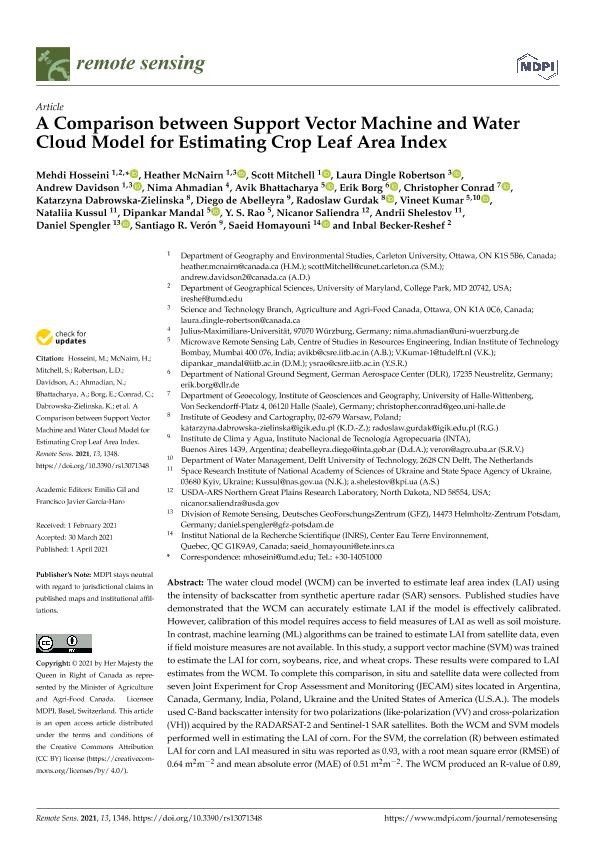Artículo
A comparison between support vector machine and water cloud model for estimating crop leaf area index
Hosseini, Mehdi; McNairn, Heather; Mitchell, Scott; Robertson, Laura Dingle; Davidson, Andrew; Ahmadian, Nima; Bhattacharya, Avik; Borg, Erik; Conrad, Christopher; Dabrowska Zielinska, Katarzyna; de Abelleyra, Diego; Gurdak, Radoslaw; Kumar, Vineet; Kussul, Nataliia; Mandal, Dipankar; Rao, Y.S.; Saliendra, Nicanor; Shelestov, Andrii; Spengler, Daniel; Verón, Santiago Ramón ; Homayouni, Saeid; Becker Reshef, Inbal
; Homayouni, Saeid; Becker Reshef, Inbal
 ; Homayouni, Saeid; Becker Reshef, Inbal
; Homayouni, Saeid; Becker Reshef, Inbal
Fecha de publicación:
04/2021
Editorial:
Multidisciplinary Digital Publishing Institute
Revista:
Remote Sensing
e-ISSN:
2072-4292
Idioma:
Inglés
Tipo de recurso:
Artículo publicado
Clasificación temática:
Resumen
The water cloud model (WCM) can be inverted to estimate leaf area index (LAI) using the intensity of backscatter from synthetic aperture radar (SAR) sensors. Published studies have demonstrated that the WCM can accurately estimate LAI if the model is effectively calibrated. However, calibration of this model requires access to field measures of LAI as well as soil moisture. In contrast, machine learning (ML) algorithms can be trained to estimate LAI from satellite data, even if field moisture measures are not available. In this study, a support vector machine (SVM) was trained to estimate the LAI for corn, soybeans, rice, and wheat crops. These results were compared to LAI estimates from the WCM. To complete this comparison, in situ and satellite data were collected from seven Joint Experiment for Crop Assessment and Monitoring (JECAM) sites located in Argentina, Canada, Germany, India, Poland, Ukraine and the United States of America (U.S.A.). The models used C-Band backscatter intensity for two polarizations (like-polarization (VV) and cross-polarization (VH)) acquired by the RADARSAT-2 and Sentinel-1 SAR satellites. Both the WCM and SVM models performed well in estimating the LAI of corn. For the SVM, the correlation (R) between estimated LAI for corn and LAI measured in situ was reported as 0.93, with a root mean square error (RMSE) of 0.64 m2m-2 and mean absolute error (MAE) of 0.51 m2m-2. The WCM produced an R-value of 0.89, with only slightly higher errors (RMSE of 0.75 m2m-2 and MAE of 0.61 m2m-2) when estimating corn LAI. For rice, only the SVM model was tested, given the lack of soil moisture measures for this crop. In this case, both high correlations and low errors were observed in estimating the LAI of rice using SVM (R of 0.96, RMSE of 0.41 m2m-2 and MAE of 0.30 m2m-2). However, the results demonstrated that when the calibration points were limited (in this case for soybeans), the WCM outperformed the SVM model. This study demonstrates the importance of testing different modeling approaches over diverse agro-ecosystems to increase confidence in model performance.
Palabras clave:
LEAF AREA INDEX
,
MACHINE LEARNING
,
RADARSAT-2
,
SENTINEL-1
,
WATER CLOUD MODEL
Archivos asociados
Licencia
Identificadores
Colecciones
Articulos(SEDE CENTRAL)
Articulos de SEDE CENTRAL
Articulos de SEDE CENTRAL
Citación
Hosseini, Mehdi; McNairn, Heather; Mitchell, Scott; Robertson, Laura Dingle; Davidson, Andrew; et al.; A comparison between support vector machine and water cloud model for estimating crop leaf area index; Multidisciplinary Digital Publishing Institute; Remote Sensing; 13; 7; 4-2021; 1-20
Compartir
Altmétricas



